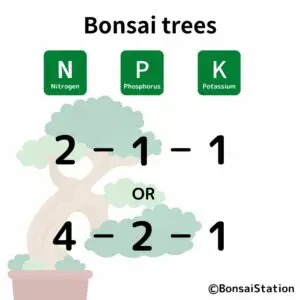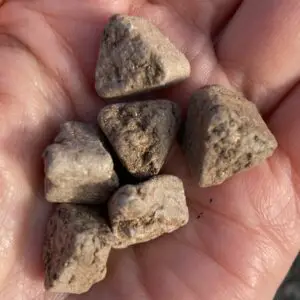When choosing a fertilizer for your bonsai trees, it’s important to consider the nutrient content, species-specific requirements, fertilizer type/form/origin, and budget. My top choice for solid fertilizer is Bonsai Fertilizer Pellets by Leaves and Soul, for liquid is Dyna-Gro Bonsai-Pro Liquid Fertilizer, and for organic is BioGold Bonsai Fertilizer.
How to choose the right bonsai fertilizer
When feeding your bonsai tree, it is important to choose a fertilizer that provides the right balance of nutrients for optimal growth and health.
Here are some key criteria to consider when choosing a fertilizer for your bonsai trees:
- Nutrient content
- Species-specific requirements
- Fertilizer type
- Fertilizer form
- Organic vs. inorganic
- Budget
Nutrient Content
As plants, bonsai trees require specific nutrients to grow and thrive. There are 17 essential nutrients that they need to grow and nitrogen (N), phosphorus (P), and potassium (K) are essential for various aspects of their growth and development, such as leafy growth, energy transfer, and general health.
Having the essential nutrients in a fertilizer is necessary but not enough; it is equally important to ensure that nutrients are in the correct balance because each of them plays a specific role in the growth of the tree. If the balance of nutrients is not correct, it can negatively impact the tree’s health and appearance.
For example, if the fertilizer has too much nitrogen, the tree may grow too quickly and its shape becomes bushy and deformed. On the other hand, if the fertilizer has too little nitrogen, the tree may not grow enough leaves, resulting in stunted growth and poor overall health.

Bonsai Trees NPK ratio
The ideal NPK balance for a basic bonsai fertilizer is 2-1-1 or 4-2-1, emphasizing the nitrogen ratio for leaf growth.
So, look for a fertilizer that provides the right balance of nutrients as well as other micronutrients such as iron, magnesium, and zinc.
Species-specific requirements
Different species of bonsai trees have different nutritional requirements. Although the basic formula of NPK 2-1-1 is applicable for all bonsai species, flowering and fruit bonsai trees have other nutrient needs, which are phosphorous for flowering and potassium for fruiting.
For these trees, a fertilizer with an N-P-K ratio of 10-10-10 will give balanced growth of their flowers when necessary.
Fertilizer type
There are fast-acting and slow-release fertilizers when categorized by nutrient release rate.
Fast-acting fertilizers dissolve quickly into the soil, providing an immediate boost to the bonsai trees. On the other hand, slow-release fertilizers release their nutrients gradually over a longer period of time, providing a sustained supply of nutrients to them.
For bonsai trees, choosing slow-release fertilizers is important because fertilizer-associated risks such as overfertilization are minimized and nutrient loss is lower.
Fertilizer Form
Fertilizers come in various forms, such as solid and liquid, and each form has its own advantages and disadvantages. For bonsai trees, both solid and liquid fertilizers can be used but using only liquid fertilizers to meet their nutrient is not recommended.
Liquid fertilizers are fast acting, which is good when bonsai trees need to be fed fast, but fertilizers in liquid form may lead to overfertilization and nutrient leaching.
A combination of slow-release solid fertilizers for basic nutrient needs and occasional liquid fertilizers for special needs is the best approach for bonsai fertilization.
Organic vs. Inorganic
Some bonsai growers prefer organic fertilizers, while others prefer inorganic. For bonsai trees, both inorganic and organic fertilizers can be used as long as they are slow-release.
Budget
Fertilizers can vary widely in price. In general, organic fertilizers tend to be more expensive compared to chemical fertilizers because chemical ones can be mass-produced with synthetic ingredients.
Note that some of the more expensive options may not necessarily be the better choice for your bonsai tree. Cheaper ones can work as effectively as expensive ones if you choose wisely.
Consider your budget and choose a fertilizer that provides the right balance of nutrients for your tree at a price you can afford.
For more about bonsai trees’ nutrition needs and the best type of fertilizers, the following post might be helpful.
The best fertilizers for bonsai trees
Here are my top picks for the best fertilizers for bonsai trees, broken down into three categories: solid fertilizer, liquid fertilizer, and organic fertilizer.
Solid Fertilizer
Slow-release solid fertilizers provide a sustained supply of nutrients for bonsai trees, reducing the need for frequent application.
Leaves and Soul Bonsai Fertilizer Pellets
(Link to Amazon)
My pick for the best solid fertilizer for bonsai trees is Bonsai Fertilizer Pellets by Leaves and Soul. This is a slow-release fertilizer in pellet form that is specifically formulated for bonsai trees.
Though synthetic, this fertilizer releases nutrients slowly over a period of 6 months, providing a steady supply of essential nutrients to the soil. It contains nitrogen, phosphorus, and potassium with an ideal balance that is suitable for all bonsai trees (NPK ratio- 18:6:8).
They are easy to apply; you simply place them on top of the soil or mix them into the soil.
Liquid Fertilizer
When you need a quick and easy fertilizing solution, liquid fertilizers are a great choice. They are easy to apply and absorb into the soil quickly, providing immediate benefits to your bonsai tree.
Dyna-Gro Bonsai-Pro Liquid Fertilizer
(Link to Amazon)
My pick for the best liquid fertilizer for bonsai trees is Dyna-Gro Bonsai-Pro Liquid Fertilizer. It is a concentrated liquid fertilizer that is specifically formulated for bonsai trees.
This fertilizer is designed to provide a balanced supply of essential nutrients to the bonsai trees, with an elevated level of phosphorus which makes it perfect for flowering and fruit bonsai trees (NPK ratio- 7:9:5) when they need a boost of nutrients for reproduction (i.e. flower/fruit).
Dyna-Gro Bonsai-Pro Liquid Fertilizer is easy to use; you can simply mix it with water and apply it to the soil or foliage of the bonsai tree. Make sure to make it twice the labeled dilution to avoid overfertilization.
As a liquid fertilizer, its nutrients are quickly absorbed by bonsai trees when they are applied.
Organic Fertilizer
For those who prefer more natural fertilizing options, organic fertilizers are a great choice.
(Link to Amazon)
My pick for the best organic fertilizer for bonsai trees is BioGold Bonsai Fertilizer. It is an organic fertilizer made from chicken manure through a Japanese traditional fertilization method.
BioGold Bonsai Fertilizer provides a balanced supply of nutrients to bonsai trees with NPK ratio of 3.5-3.7-3.3 and supplies ample minerals (micronutrients) necessary for bonsai as well.
It is easy to use; you can simply top-dress the soil with it or put some pieces into water to make it liquid form. It releases nutrients for about 2 months when applied on top of the soil, and about 10 days in liquid form.

BioGold Bonsai fertilizer
BioGold Bonsai Fertilizer is a go-to bonsai fertilizer for many bonsai enthusiasts in Japan and all over the world. This is an ideal fertilizer for those who prefer an organic approach to fertilizing their bonsai trees, as it does not contain any synthetic chemicals.
If you are interested in making your own bonsai fertilizer at home, the following post explains in detail how to do it.
No matter which type of fertilizer you choose, make sure to follow the manufacturer’s instructions for application and not over-fertilize, as this can be harmful to your bonsai trees.
If you want to know how to fertilize bonsai trees step by step, the following post shows exactly how.




